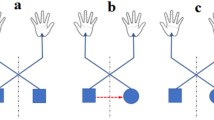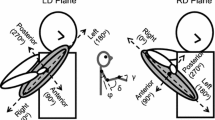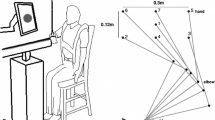Summary
Normal human subjects grasped a 3-D isometric handle with an otherwise unrestrained, pronated hand and exerted forces continuously to draw circles, ellipses and lemniscates (figure-eights) in specified planes in the presence or absence of a 3-D visual force-feedback cursor and a visual template. Under any of these conditions and in all subjects, a significant positive correlation was observed between the instantaneous curvature and angular velocity, and between the instantaneous radius of curvature and tangential velocity; that is, when the force trajectory was most curved, the tangential velocity was lowest. This finding is similar to that obtained by Viviani and Terzuolo (1982) for 2-D drawing arm movements and supports the notion that central constraints give rise to the relation between geometric and kinematic parameters of the trajectory.
Similar content being viewed by others
References
Bernstein N (1967) The co-ordination and regulation of movements. Pergamon Press, Oxford
Caminiti R, Johnson PB, Urbano A (1990) Making arm movements within different parts of space: Dynamic aspects in the primate motor cortex. J Neurosci 10: 2039–2058
Flash T (1987) The control of hand equilibrium trajectories in multijoint arm movements. Biol Cybern 57: 257–274
Flash T, Hogan N (1985) The coordination of arm movements: an experimentally confirmed mathematical model. J Neurosci 5: 1688–1703
Georgopoulos AP, Caminiti R, Kalaska JF, Massey JT (1983) Spatial coding of movement: a hypothesis concerning the coding of movement direction by motor cortical populations. Exp Brain Res [Suppl] 7: 327–336
Georgopoulos AP, Kalaska JF, Crutcher MD, Caminiti R, Massey JT (1984) The representation of movement direction in the motor cortex: single cell and population studies. In: GM Edelman, WM Cowan, WE Gall (eds) Dynamic aspects of neocortical function. Wiley, New York, pp 501–524
Georgopoulos AP, Kettner RE, Schwartz AB (1988) Primate motor cortex and free arm movements to visual targets in three-dimensional space. II. Coding of the direction of movement by a neuronal population. J Neurosci 8: 2928–2937
Georgopoulos AP, Lurito JT, Petrides M, Schwartz AB, Massey JT (1989) Mental rotation of the neuronal population vector. Science 243: 234–236
Georgopoulos AP, Massey JT (1987) Cognitive spatial-motor processes. 1. The making of movements at various angles from a stimulus direction. Exp Brain Res 65: 361–370
Georgopoulos AP, Schwartz AB, Kettner RE (1986) Neuronal population coding of movement direction. Science 233: 1416–1419
Hollerbach JM, Flash T (1982) Dynamic interactions between limb segments during planar arm movement. Biol Cybern 44: 67–77
Jeannerod M (1984) The timing of natural prehension movements. J Mot Behav 16: 235–254
Kalaska JF, Cohen DAD, Hyde ML, Prud'homme M (1989) A comparison of movement direction-related versus load direction-related activity in primate motor cortex, using a two-dimensional reaching task. J Neurosci 9: 2080–2102
Lacquaniti F, Terzuolo C, Viviani P (1983) The law relating the kinematic and figurai aspects of drawing movements. Acta Psychol 54: 115–130
Lurito JT, Georgakopoulos T, Georgopoulos AP (1991) Cognitive spatial-motor processes. 7. The making of movements at an angle from a stimulus direction: studies of motor cortical activity at the single cell and population levels. Exp Brain Res (in press)
Lurito JT, Massey JT, Georgopoulos AP (1990) Radius of curvature and tangential velocity covary in continuously exerted three-dimensional (3D) isometric forces. Soc Neurosci Abstr 16: 1087
Massey JT, Drake RA, Lurito JT, Georgopoulos AP (1991) Cognitive spatial-motor processes: 4. Specification of the direction of visually guided isometric forces in two-dimensional space: information transmitted and effects of visual force feed-back. Exp Brain Res 83: 439–445
Massey JT, Hovey GW, Schneider W, Chubbuck JG, Georgopoulos AP (1988) A method for studying the control of three-dimensional isometric forces using dynamic sterogram. J Neurosci Meth 26: 123–127
Pellizzer G, Massey JT, Bains H, Georgopoulos AP (1991) Are there common processing constraints for visuomotor and perceptual mental rotations? Soc Neurosci Abstr 17: 1226
Rosenbaum DA (1980) Human movement initiation: specification of arm, direction, and extent. J Exp Psychol, General 109: 444–474
Schwartz AB (1988) Motor cortical discharge during sinusoidal arm trajectories. Soc Neurosci Abstr 14: 343
Schwartz AB, Anderson BJ (1989) Motor cortical images of sinusoidal trajectories. Soc Neurosci Abstr 15: 788
Shepard RN, Cooper L (1982) Mental images and their transformations. MIT Press, Cambridge MA
Soechting JF, Lacquaniti F (1981) Invariant characteristics of a pointing movement in man. J Neurosci 1: 710–720
Soechting JF, Lacquaniti F, Terzuolo CA (1986) Coordination of arm movements in three-dimensional space. Sensorimotor mapping during drawing movement. Neuroscience 17: 295–311
Soechting JF, Terzuolo CA (1986) An algorithm for the generation of curvilinear wrist motion in an arbitrary plane in three-dimensional space. Neuroscience 19: 1393–1405
Taira M, Ashe J, Smyrnis N, Georgopoulos AP (1991) Motor cortical cell activity in a visually guided isometric force pulse task. Soc Neurosci Abstr 17: 308
Viviani P, Cenzato M (1985) Segmentation and coupling in complex movements. J Exp Psychol, Hum Perc Perf 11: 828–845
Viviani P, McCollum G (1983) The relation between linear extent and velocity in drawing movements. Neuroscience 10: 211–218
Viviani P, Schneider R (1991) A developmental study of the relationship between geometry and kinematics in drawing movements. J Exp Psychol, Hum Perc Perf 17: 198–218
Viviani P, Terzuolo C (1982) Trajectory determines movement dynamics. Neuroscience 7: 431–437
Wann J, Nimmo-Smith I, Wing AM (1988) Relation between velocity and curvature in movement: equivalence and divergence between a power law and a minimum-jerk model. J Exp Psychol, Hum Perc Perf 14: 622–637
Author information
Authors and Affiliations
Rights and permissions
About this article
Cite this article
Massey, J.T., Lurito, J.T., Pellizzer, G. et al. Three-dimensional drawings in isometric conditions: relation between geometry and kinematics. Exp Brain Res 88, 685–690 (1992). https://doi.org/10.1007/BF00228198
Received:
Accepted:
Issue Date:
DOI: https://doi.org/10.1007/BF00228198




